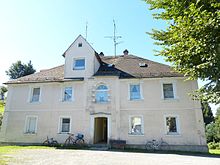Singing mill
The Absängermühle is a former mill in Stammbach in the Upper Franconian district of Hof . It is under monument protection (D-4-75-175-30).
The Absängermühle Blumenau 15 is now a two-story main building with a hipped roof . It is structured with pilaster strips . The keystone of the entrance bears the year 1841 and the coat of arms of the Schneider family . Remnants of the mill ditch are still there.
The singing mill comes from the beginning of the settlement of the region, it probably already existed at the time of the whale pots . As a free property there were always disputes about individual rights in later centuries, especially between the bishopric of Bamberg as a feudal lord and the Margraviate Bayreuth-Kulmbach , which u. a. the high jurisdiction claimed. The sawmill , and later the hammer mill , probably came through the Andechs-Meranier to the Langheim monastery , which in 1384 sold various properties to the Bamberg bishop Lamprecht von Brunn to repay debts . It owes its current name to the first known owner from 1495, Cuntz Absenger. In the Forchheim Treaty of 1538, Bishop Weigand von Redwitz and Margrave Georg agreed that the margrave had jurisdiction over the highest courts. Nevertheless, there were always legal disputes. The families von Schnee , Nanckenreuth , Reitzenstein , Hirschberg and Wallenrode were among the noble owners since the beginning of the 17th century .
literature
- Helmut Hennig: The history of Stammbach - from the beginnings to the founding of the empire . Wunsiedel 1989. pp. 140-148.
Web links
Coordinates: 50 ° 8 ′ 35.2 ″ N , 11 ° 41 ′ 6.3 ″ E
